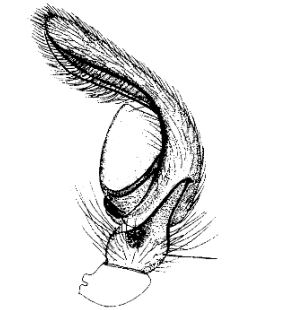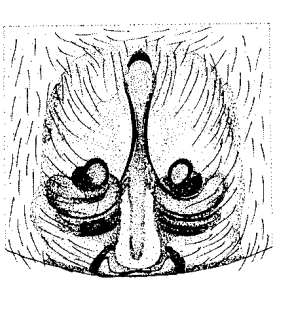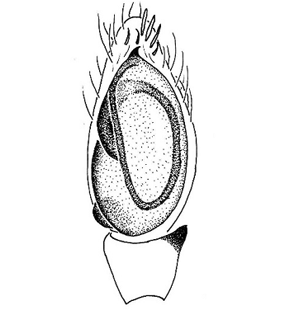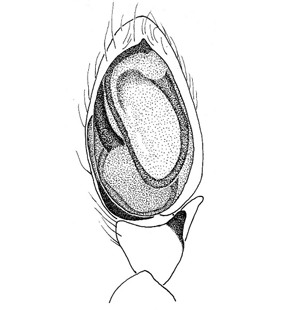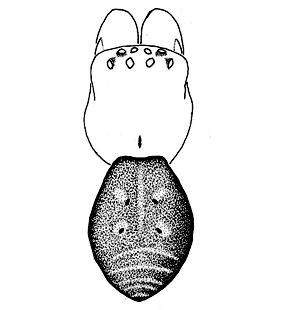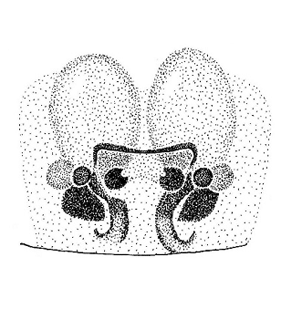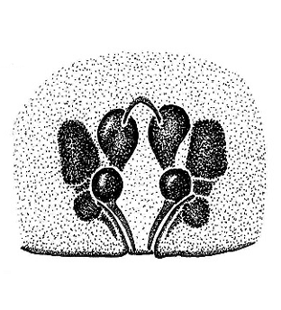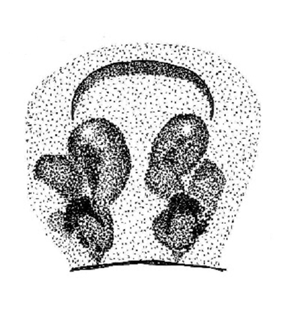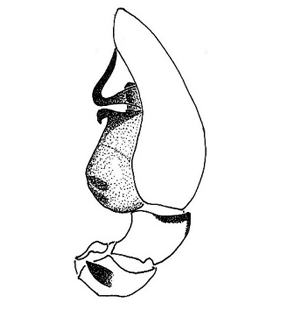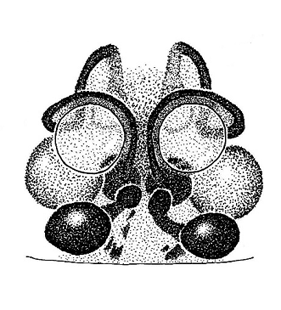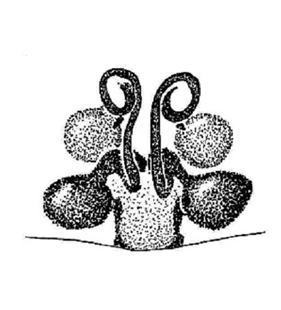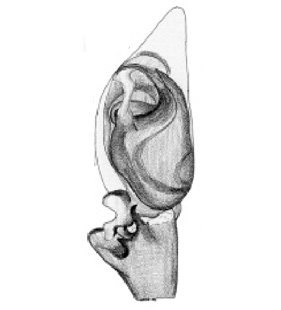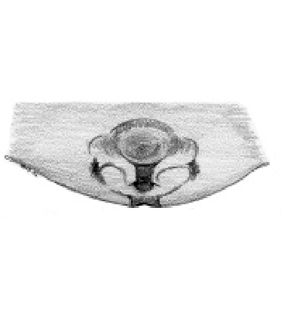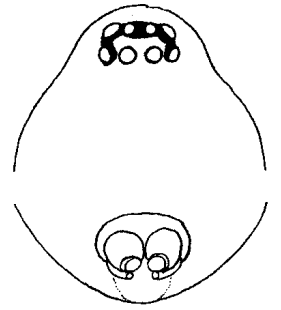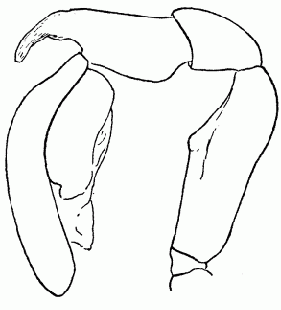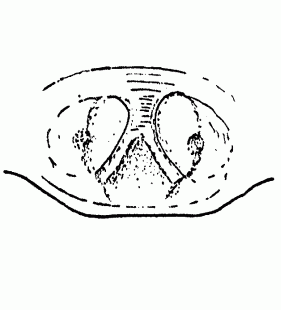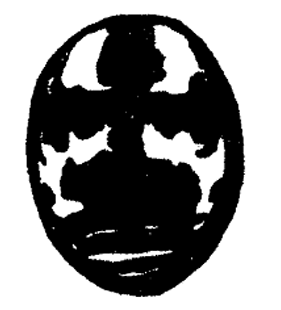Familie Corinnidae Karsch, 1880
|
Für Fehlermeldungen oder Verbesserungsvorschläge bitte Link folgen: click
|
||||||||
| 1 |
Beine ohne Borsten, bei Männchen können aber mindestens Tibia und Metatarsus I-II ventral-laterale Reihen von sehr kurzen Stacheln oder verdickten Haaren haben. Prosoma meist deutlich konvex, mit einer meist deutlich runzeligen Cuticula, Cheliceren meist kräftig |
|||||||
| - | Beine mit Borsten, z.B. als lange, paarige ventral Borsten an Tibia und Metatarsus des Vorderbeines, keine verdickten Haare. Prosoma meist flach, kräftige Cheliceren nur bei Creugas |
|||||||
| 2 (1) |
Körperlänge 5-7 mm, Genitalorgane wie Abbildung, unter Rinde Trachelidae |
| ||||||
| - | Körperlänge unter 5 mm, Genitalorgane anders, bodenlebend |
|||||||
| 3 (2) |
Beim Männchen Tibia und Metatarsus I-II mit ventral-lateralen Reihen von sehr kurzen Stacheln oder verdickten Haaren, Opisthosoma des Männchen mit dorsalem Scutum, Epigyne anderes |
|||||||
| - | Beim Männchen Tibia und Metatarsus I-II ohne verdickte Haare, Opisthosoma des Männchen ohne dorsales Scutum, Epigyne wie Abbildung Trachelidae |
|||||||
| 4 (3) |
Männlicher Pedipalpus ohne Patellarapophyse, Epigyne vorne mit Haube oder Kante Trachelidae |
| ||||||
| - | Männlicher Pedipalpus mit Patellarapophyse, Epigyne vorne ohne Haube oder Kante Trachelidae |
| ||||||
| 5 (1) |
Körperlänge 5 – 8.6 mm, Metatarsen I-II mit 2 Paar ventraler Borsten |
|||||||
| - | Körperlänge 2 – 5 mm, Metatarsen I-II mit mindestens 3 Paar ventraler Borsten |
|||||||
| 6 (5) |
Tibia I mit 5 Paar ventraler Borsten, Beine III-IV mit zahlreichen Borsten, Körper stämmig, Prosoma 1.23-1.34 mal länger als breit, beim Männchen Pedipalpentibia mit 3 Apophysen, Epigyne mit 2 Vertiefungen |
| ||||||
| - | Tibia I mit 2 Paar ventraler Borsten, Beine III-IV ohne oder nur mit sehr wenigen Borsten, Körper schlank, Prosoma 1.34-1.48 mal länger als breit, beim Männchen Pedipalpentibia ohne Apophysen, nur mit einem Haken, Epigyne wie Abbildung |
|||||||
| 7 (5) |
Spinnen mit Ameisenmimikry, dunkles Opisthosoma mit weissen Flecken, Femur des männlichen Pedipalpus mit ventralem Höcker |
|||||||
| - | Spinnen ohne Ameisenmimikry, Femur des männlichen Pedipalpus ohne ventralem Höcker |
|||||||
| 8 (7) |
Alle Femora mit einer dorso-basalen Borste, 2-4 promarginale und 2 retromarginale Zähne auf dem Klauenfurchenrand der Cheliceren |
|||||||
| - | Dorso-basale Borsten fehlen zumindest an Femora III-IV, keine promarginale und ein retromarginaler Zahn auf dem Klauenfurchenrand der Cheliceren Phrurolithidae |
| ||||||
| 9 (8) |
Zwei Tibialapophysen am männlichen Pedipalpus, eine davon kurz, Epigyne mit grosser Vertiefung wie Abbildung Phrurolithidae |
| ||||||
| - | Eine grosse, schlanke Tibialapophyse am männlichen Pedipalpus, Epigyne wie Abbildung Phrurolithidae |
|||||||
| 10 (7) |
Körperlänge 2-4 mm, Cheliceren vorne ohne Borste in basaler Hälfe, Prosoma und Opisthosoma einfarbig, Prosoma rötlich (verblasst in Alkohol zu orange), Opisthosoma langoval (Nebenbemerkung: Arabelia wird derzeit noch als zu den Liocranidae gehörig betrachtet, könnte sich aber als Corinnidae erweisen)
|
|||||||
| - | Körperlänge unter 2 mm, Cheliceren vorne mit Borste in basaler Hälfe, Prosoma und Opisthosoma zweifarbig (hell und dunkel grau), Opisthosoma kurz ovoid Phrurolithidae |
|
Weitere Gattungen
- 1. Corinna
- 2. Falconina
- 3. Graptartia
- 4. Procopius
- 5. Scorteccia
- 6. Simonestus
